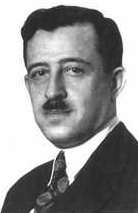Sami Ibrahim Haddad
Sami Ibrahim Haddad, Arabic: سامي ابراهيم حداد (July 3, 1890 – February 5, 1957) was a doctor, surgeon and writer. He was born in Palestine and spent most of his life in Lebanon.
Sami Ibrahim Haddad M.D., I.S.S., F.A.C.S., G.M.B. | |
|---|---|
 | |
| Native name | Arabic: سامي ابراهيم حداد |
| Born | July 3, 1890 Jaffa, Palestine |
| Died | February 5, 1957 (aged 66) Beirut, Lebanon |
| Occupation | Doctor, Surgeon |
| Nationality | Lebanese |
Life
He achieved preparatory education at the Bishop Gobat School (1901–1905) and the English College (1907–1909) in Jerusalem. This left an indelible mark on him. His assertiveness, honesty, discipline, and austerity most probably derived from his early Scottish high school teachers in Jerusalem, where he earned the Gibbon Memorial Prize in July 1906. He graduated with a Medical Doctor (MD) degree from the Syrian Protestant College (SPC) in 1913. Founded in 1866 by the American missionaries in Beirut (Lebanon), the SPC was renamed in 1920 as the American University of Beirut. For seven years after graduation (1913–1919), he practiced general medicine and public health, and taught the basic medical sciences at SPC. In 1919, he was nominated physician in charge of the Mental Disease Hospital at Asfuriyeh. When the U.S. King-Crane Commission (created by President Woodrow Wilson to poll public opinion in Syria, Lebanon and Palestine) arrived in Beirut, he became its physician and interpreter.
Before he joined the Department of Surgery of the American University of Beirut as Adjunct Professor of Surgery in 1929, he was granted a Rockefeller fellowship. He married Lamia Morcos (1896–1994) who helped him raise six children. One of whom was Dr. Fuad Sami Haddad, "...the founder of modern neurosurgery in Lebanon."[1]
Medical Research
He traveled to the United States of America for a training in urology at the Johns Hopkins University under the mentorship of Dr. Hugh Hampton Young. After ten years of industrious preparation and study (1913–1922), Haddad embarked on the path of teaching and practicing urology and surgery.
He taught medical students, interns, and residents and operated on several patients. In his spare time, he collected Arabic medical manuscripts and wrote about the history of Arabic medicine. He kept abreast of new medical developments through trips abroad to the United States, Austria, Brazil, Australia, Iraq, Qatar, England, France, and Spain. During his trips, he photographed Arabic medical manuscripts and other important documents related to the history of Arabic medicine in the libraries of Paris, London, and Jerusalem.
He became a member of the International Society for Surgery in 1931, a Fellow of the American College of Surgeons in 1934, a member of the Council of AUB, and in 1941, Chairman of AUB's Department of Surgery and Dean of its Medical School. He was awarded the Lebanese Honorary Golden Order of Merit both in 1954 and 1956.
He was proficient in Arabic and English and learned French, German and Syriac for his archival research in history. He wrote almost a hundred articles on various medical topics including genera surgery and urology, and half in English and half in Arabic. Ten of his books were written in English, including Notes on Embryology (unpublished), Essentials of Urinary and Genital Disease (1946), and eight volumes of the Annual Report of the Orient Hospital (AROH) (1948–1955). The Contributions of the Arabs to the Medical Sciences (1936) and The Tradition According to Omar (1940) were written in Arabic. His articles on urology dealt with cystoscopy, pyolography, hematuria, genitourinary tuberculosis, renal and ureteral lithiasis, hemangioma of the urinary bladder, calculi, prostatic enlargement, and prostatic cancer.
He also published articles on various forms of cancers, and the art of surgery. His research on the history of medicine resulted in articles on hospitals in the Arab world, Ibn al-Nafis (the 19th-century physician who discovered pulmonary circulation), Hippocrates, Galen, Arab dentistry, cesarean section, medical ethics, medical biographies, and a catalogue of the Arabic medical manuscripts he had collected. He also wrote the history of Arabic script, the medical problems in Arab countries, and the Mameluke documents concerning the church of the Nativity in Jerusalem.
Orient Hospital of Beirut
In 1947, he founded the Orient Hospital, a fifty-four bed non-profit institution, and shouldered the responsibility of its varied and intricate administration. "He was its founder, superintendent, chief of staff, chief surgeon, roentgenologist, record keeper, and editor of its Annual Report."[2]
Death
Sick with heart disease the last five years of his life, he died on February 5, 1957, in Beirut. At the funeral, his students carried his coffin to the National Evangelical Church of Beirut.
References
- Turgut, Mehmet (January 16, 2016). "Professor Dr. Fuad Sami Haddad, BA, MD, FRCS (C), FACS". Acta Neurochirurgica. 158 (3): 405–6. doi:10.1007/s00701-016-2708-5. PMID 26780620.
- Haddad, Farid; Haddad, Saad. "Sami Ibrahim Haddad". Retrieved March 23, 2018.
External links
| Wikiquote has quotations related to: Sami Ibrahim Haddad |